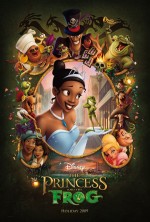Once Upon a Time, In a Place Called "Crescent City"...
2009 // USA // Ron Clements and John Musker
// December 13, 2009
// Theatrical Print (AMC West Olive)
B - It's been five years since Disney Animation Studios has produced a narrative feature that was at least partly hand-drawn, and longer than that since the venerable House of Mouse's roughly annual doses of animated cheer could be regarded as unique cinematic events. (1999's Tarzan being the last triumph by my reckoning.) It's not surprising, then, that The Princess and the Frog is being trumpeted by the studio itself as a kind of overdue return to form. In the wake of forgettable computer-generated mediocrities such a Chicken Little and Meet the Robinsons, there is a steely logic in Disney's decision to abandon its anemic Pixar apings and instead pursue films created according to the template of its successful Renaissance features. Indeed, TPatF possesses all the hallmarks of the studio's 1990s films: hand-drawn animation embellished with dazzling visual effects; Broadway-style musical storytelling; a young, appealing protagonist; goofy comic relief characters; and simplistic moral lessons. Perhaps it's the long absence of that Disney Magic(TM)—benign, kid-friendly entertainment executed with stunning visual achievement—that makes that familiarity work so well in The Princess and the Frog. Certainly, there's very little that's unexpected in Ron Clements and John Musker's Jazz Age fairy tale. However, there's also nothing wrong with following a formula when the result is so gorgeous. Just as Pixar has established itself as preeminent purveyor of children's fare that is thematically richer and more downright cinematic than most "adult" features, Disney Animation Studio once made unbearably lovely moving picture books, far lovelier than their often crude stories or questionable politics warranted. Perhaps the highest praise one can offer The Princess in the Frog is that it reignites that latent tradition with enthusiasm and boundless affection for its forebears.
The original Frog Prince fairy tale, as told by the Brothers Grimm, is thin gruel for a feature-length film. (It doesn't even include a kiss!) Accordingly, Clements, Musker, and co-writer Rob Edwards have taken the story's popularly understood premise—a prince is cursed with the form of a frog until he is freed by a princess' kiss—and transformed it into a brisk, voodoo-touched tale of 1920s New Orleans. While Disney has previously shaded their fantastical settings in different ways, TPatF is the closest the studio has ever come to attempting a "modern dress" version of a fairy or folk tale. And, truth be told, it works astonishingly well, partly because the film-makers exhibit such obvious adoration for the city's unique sights, sounds, and tastes, partly because they ground every inch of their story in the New Orleans' unique milieu (even if it is ultimately a Disneyfied version of the city). Far from serving as arbitrary window dressing, Clements and Musker's selection of time and place is woven into the narrative quite adroitly, right down to a cunning little conceit regarding a princess (of sorts) and a midnight deadline.
As a feature explicitly designed to fit into Disney's "Princess film" stream—a cynically retroactive bit of branding if there ever was one—TPatF accordingly boasts a young, beautiful, female protagonist, but she is without a doubt one of the most well-rounded such characters in Disney history. She is also black, a fact that has been difficult to miss given the past year's worth of hubbub about the film, some of it no doubt of the self-congratulatory sort. No matter. Whether Tiana (Anika Noni Rose) originated as a bit of niche marketing or not, she is a wholly appealing character on the screen, treated with the sort of care and warmth that few Disney heroes are afforded. To be sure, the film tiptoes gingerly around matters of race, as much as any fantasy set in early twentieth century American South can. The closest the film gets to stepping directly on that particular hornet's nest is a lawyer's comment to Tiana about "someone of your background." Still, to this white viewer, TPatF threads the race needle quite well, acknowledging racial disparities while maintaining an appropriately storybook tone, and giving black characters prominence without resorting to caricature. The film does sometimes shy away from context a bit too determinedly—there's no hint as to why Tiana and her family live in a shack while her white friend Charlotte (Jennifer Cody) lives in a mansion—but this is an animated children's musical, and perhaps we can only ask so much.
More refreshing than its respectful yet velveteen approach to race is the film's treatment of gender, for here we have the culmination of the self-critique that Disney began and fumbled somewhat in Enchanted. Charlotte, for all that she is presented as a lovable and loyal friend to Tiana, is unmistakably a buffoonish character, and it's therefore notable that her most dominant personality trait is her obsession with living out the dream of a fairy tale princess, especially the part about marrying a prince. Indeed, Charlotte is for all practical purposes a joke at the expense of the very same pig-tailed mini-consumers that Disney itself has nurtured. Whether one finds this cheaply reflexive is a matter of taste, but it's notable that Charlotte, for all her spoiled, dimwitted vanity, is never presented as a bad person. She serves mainly to contrast with Tiana, a young woman defined by her strong work ethic and independence. Tiana's fondest dream is to open an elegant restaurant in the Big Easy; finding a man isn't even on her radar. Remarkably, Clements and Musker present a fairly grounded rebuke to Disney's own ethos of effortless miracles. In a gentle prologue, young Tiana's father (Terrence Howard) explains that wishing for something is all well and good, but you have to apply yourself to achieve what you want. These gestures add up to make TPatF the most enlightened Disney animated feature in decades, perhaps ever. That's faint praise given the studio's conservatism, but it's nonetheless an invigorating thing to see it unfold.
The prince of this tale is Naveen (Bruno Campos), the arrogant, shiftless, but generally good-natured scion of a fictional Mediterranean kingdom. Besotted with women and American jazz, Naveen has been cut off from his parents' fortunes, and is on the prowl for a rich socialite. Naturally, Charlotte, as the only daughter of the fabulously wealthy Big Daddy La Bouff (John Goodman), fits the bill nicely. Unfortunately, Naveen falls into the clutches of a malevolent voodoo priest, Dr. Facilier (an exquisite Keith David), who transforms the prince into a frog and Naveen's venal porter Lawrence (Peter Bartlett) into the prince's double, putting into motion a plan to seize Big Daddy's millions. Things go from bad to worse at a costume gala in the prince's honor, where Naveen, having escaped from Facilier's clutches but still trapped in his amphibious form, runs into Tiana. Mistaking her for a princess and presuming that the famous fairy tale had things right, Naveen coerces a kiss from her. Unfortunately, Tiana discovers that kissing a cursed prince when you aren't a princess only spreads the curse like a virus, and she too finds herself green and web-footed. The pair escape into the bayou and from there the film takes on a familiar shape, as they pick up a couple of comic relief companions and make their way to the voodoo priestess Mama Odie (Jenifer Lewis) in search of a cure.
The character designs are all distinctive and pleasing, especially Tiana herself, who is easily the most appealingly drawn and animated Disney female since Beauty and Beast's Belle. Rose's performance fits the character snugly, lending an authenticity to her sharp personality and slightly restrained emotions that few animated characters can boast. In frog form, Tiana and Naveen are much more simply designed, but the simplification works well, especially for Naveen, who roguish qualities actually seem enhanced by the transformation. The film-makers utilize a much more cartoonish look for Louis (Miachel-Leon Wooley), an alligator with ambitions as a jazz trumpeter, and Ray (Jim Cummings), a Cajun lightning bug, but this is to be expected given that they are the film's designated comic relief. However, in any Disney animated feature the standout character is inevitably the villain, and Dr. Facilier is no exception. The lanky, silken Facilier is not an overtly comic nasty like Aladdin's Jafar, but neither is he so manifestly lethal as, say, Sleeping Beauty's Malificent. With his skull-and-bones-bedecked top hat and handful of tarot cards, he's every inch the Hollywood conception of a vodoun bokor, but it's the little details of his design that stick, such as his white spats, conspicuous tooth gap, or the stray curl of oiled hair. Veteran screen and voice performer David delivers a marvelous turn, and the writers cunningly emphasize the curiously transactional nature of Facilier's black magic.
Strictly as a example of contemporary "traditional" animation, TPatF is stuffed to bursting with wondrous sights. Every inch of the film drips with dazzling design, lovingly rendered landscapes, and sumptuous lighting. It's simply a drop-dead gorgeous film, and if that only counts for so much in cinema, it counts for quite enough when it's done as well as this. Clements and Musker can boast at having delivered the most beautiful work of hand-drawn feature animation since, well, Tarzan, which I suppose means that TPatF does indeed signal a Second Renaissance for the House of Mouse. The musical numbers in particular showcase some of the film's best moments: the dizzying whorls of fireflies in "Gonna Take You There"; the day-glo voodoo nightmare of "Friends on the Other Side"; and, most memorably, an art deco cut-out fantasy in "Almost There". Randy Newman's songs, which appropriately sample jazz, gospel, and zydeco influences, aren't particularly memorable, in that you don't come out of the theater humming them. Yet if there's no obvious "Be Our Guest" or "Hakuna Matata," neither is there a clunker in the bunch, and for a notoriously musical-phobic viewer such as myself, that's saying something.
The Princess and the Frog is, in most ways, a utterly benign and conservative piece of film-making. It hews closely to the conventions of every animated musical fairy tale that has gone before, and in those places where it shyly steps into the twenty-first century, the move has been long overdue. What sets it apart from the junk food that passes for much children's animation is the absence of anything disposable or perfunctory about it. Clements and Musker and the dozens of animators and writers that labored on it have delivered a straight-up beautiful thing within a mode of film-making that has suffered devastating erosion in the past decade. To be sure, TPatF isn't thematically ambitious, but it is plainly a work of deep love, and it wants us to love it too. The film succeeds in this endeavor by mating exquisite visual artistry with the warm, undemanding fuzziness of a fairy tale. That, more than anything, was what characterized Disney Magic(TM), and it's what makes The Princess and the Frog such a delectable comeback.









